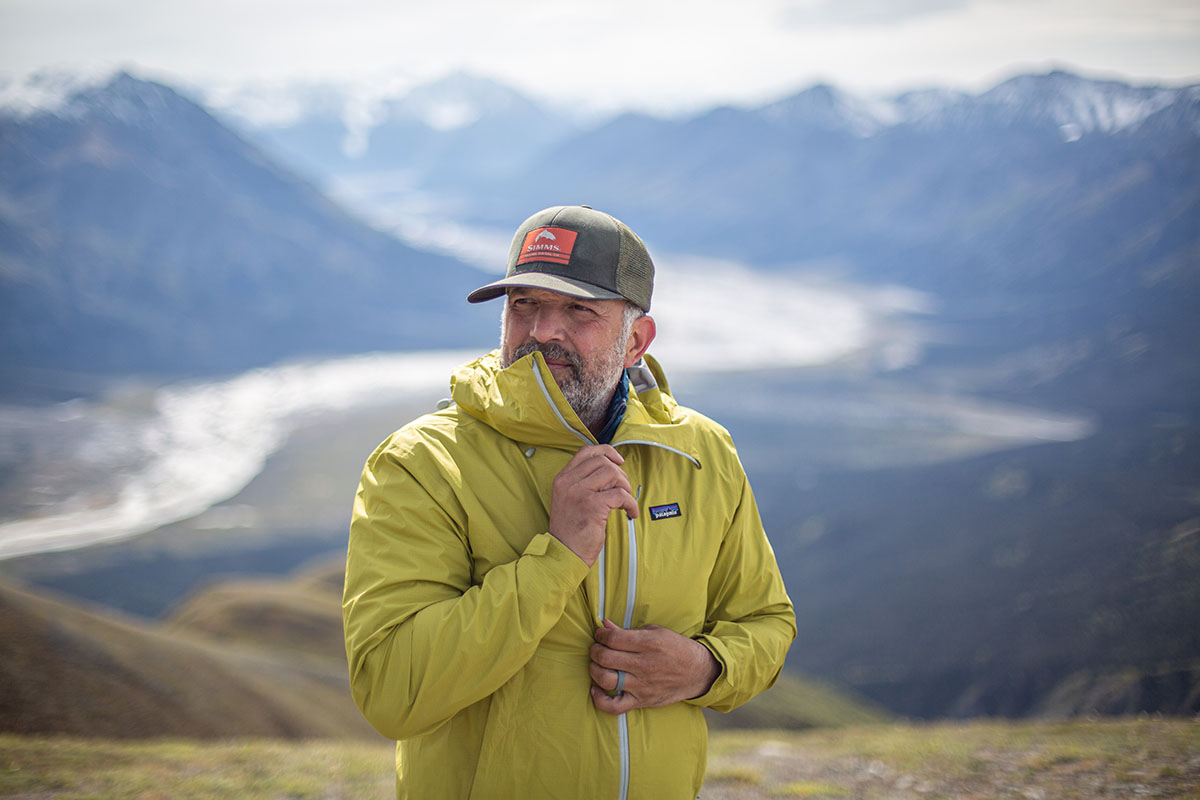
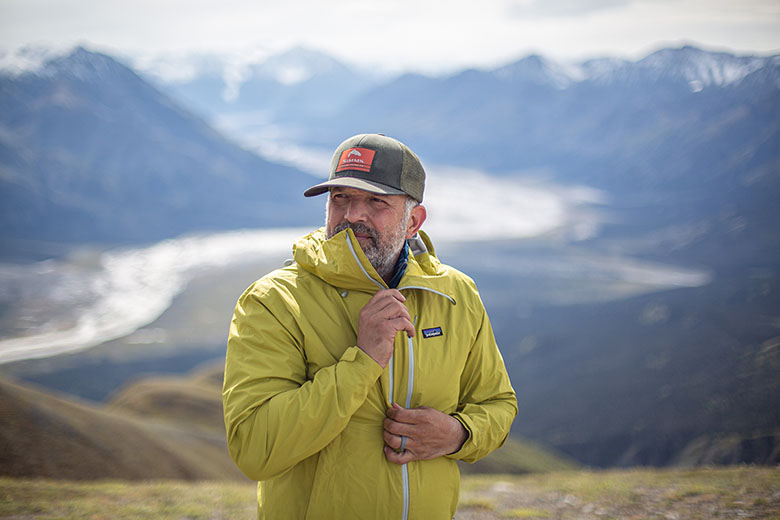
Price: $279
Weight: 1 lb. (men’s large)
Waterproofing: 3L H2No Performance Standard
What we like: Well-rounded performance and strong sustainability slant.
What we don’t: The back of our jacket wetted out in heavy rain; not particularly light.
See the Men's Granite Crest Jacket See the Women's Granite Crest Jacket
Patagonia’s rain jacket lineup covers the full gamut, from the budget-friendly Torrentshell to the running-focused Storm Racer. The mid-range Granite Crest strikes a nice middle ground for many hikers and other outdoor-goers, with quality 3-layer protection, a well-executed feature set, and a strong focus on sustainability. I did experience some wetting out along the back during an onslaught in Canada’s Yukon Territory, but I was overall impressed by the jacket’s balanced performance throughout testing. Below I outline my experiences with the men’s Granite Crest Jacket (we’ve also tested and reviewed the women’s Granite Crest). To see how it stacks up to the competition, check out our article on the best rain jackets.
The Granite Crest Rain Jacket features Patagonia’s 3-layer H2No membrane, which has proven to be a mostly solid performer throughout testing. The only time the shell showed any vulnerability was during a torrential rainstorm in Tombstone Territorial Park, when I was forced to exit our tent to adjust the guylines due to strong winds. Despite limited exposure to the onslaught, I noticed some dampness along my back when I crawled back inside the tent. To be fair, the shell deftly fended off light moisture during less intense storms on our trip, and no other areas have wetted out thus far. The Granite Crest also cuts wind nicely—enough so that I wore it every morning and evening at camp and was quick to throw it on while traversing gusty ridgelines in the Yukon.
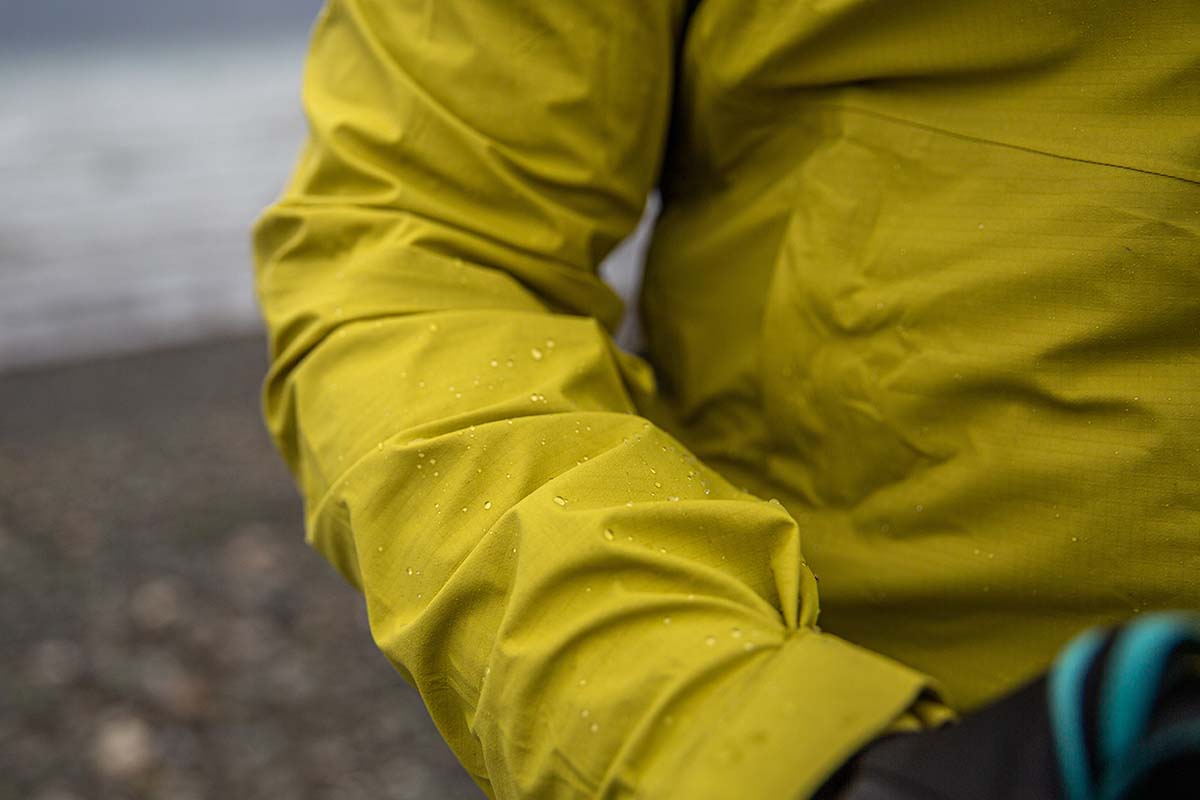
In addition to the 3-layer membrane and durable water-repellent (DWR) finish, Patagonia equipped the Granite Crest with several weather-ready touches. First is the hood, which is both climbing helmet-friendly and easy to adjust via one drawcord at the back and two at the front (more in “Key Features” below). You also get hook-and-loop cuffs for sealing out moisture and wind at the wrists; water-resistant zippers on the center zipper, chest pocket, and pit zips; and zipper garages for added assurance against moisture creeping in and damaging valuables. The pockets are reliable enough that I’ve had no qualms about leaving my phone and maps inside in inclement weather.
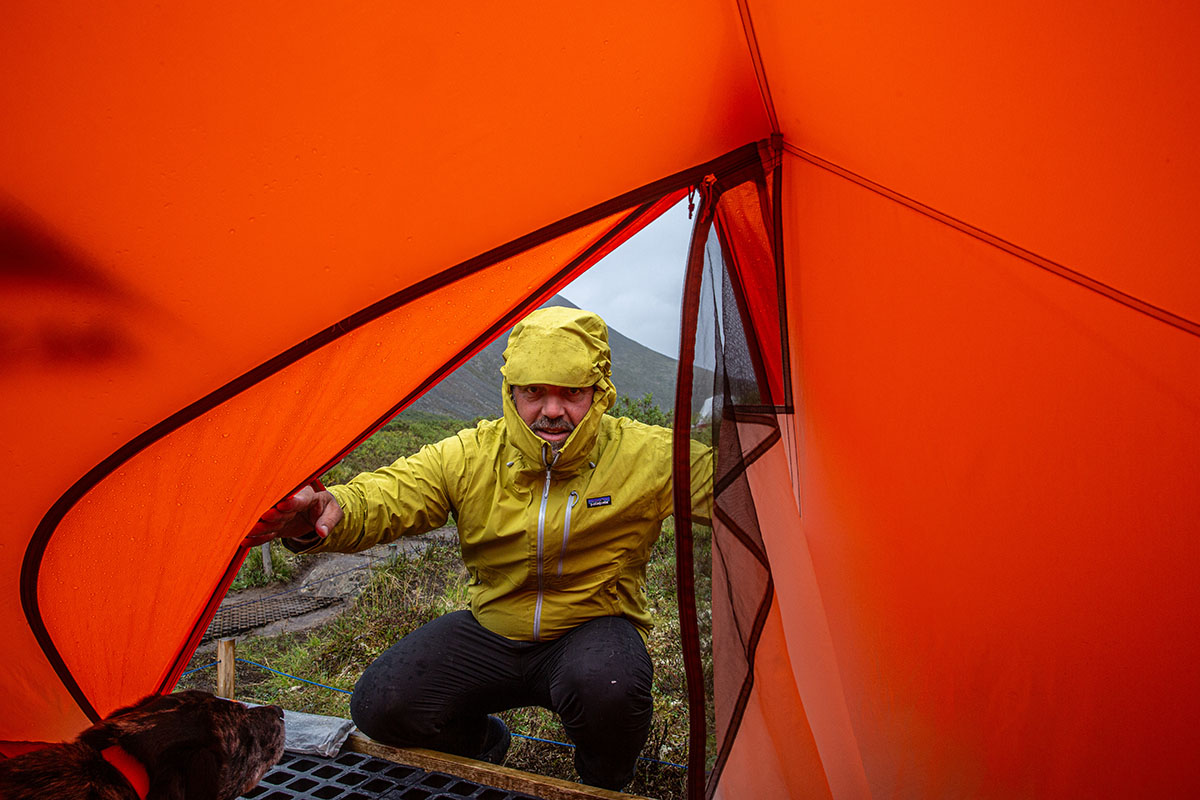
I run decidedly warm and sweat out of most waterproof shells quickly, but the Granite Crest Rain Jacket proved more breathable than expected. In fact, I found it quite comfortable while ascending the long, sustained hill from Grizzly Lake over Glissade Pass in Tombstone Territorial Park. The generously sized pit zips certainly helped, allowing me to dump some of the excess heat quickly. I did end up overheating as the rain dissipated but managed to hike several miles in the shell before needing to take it off.
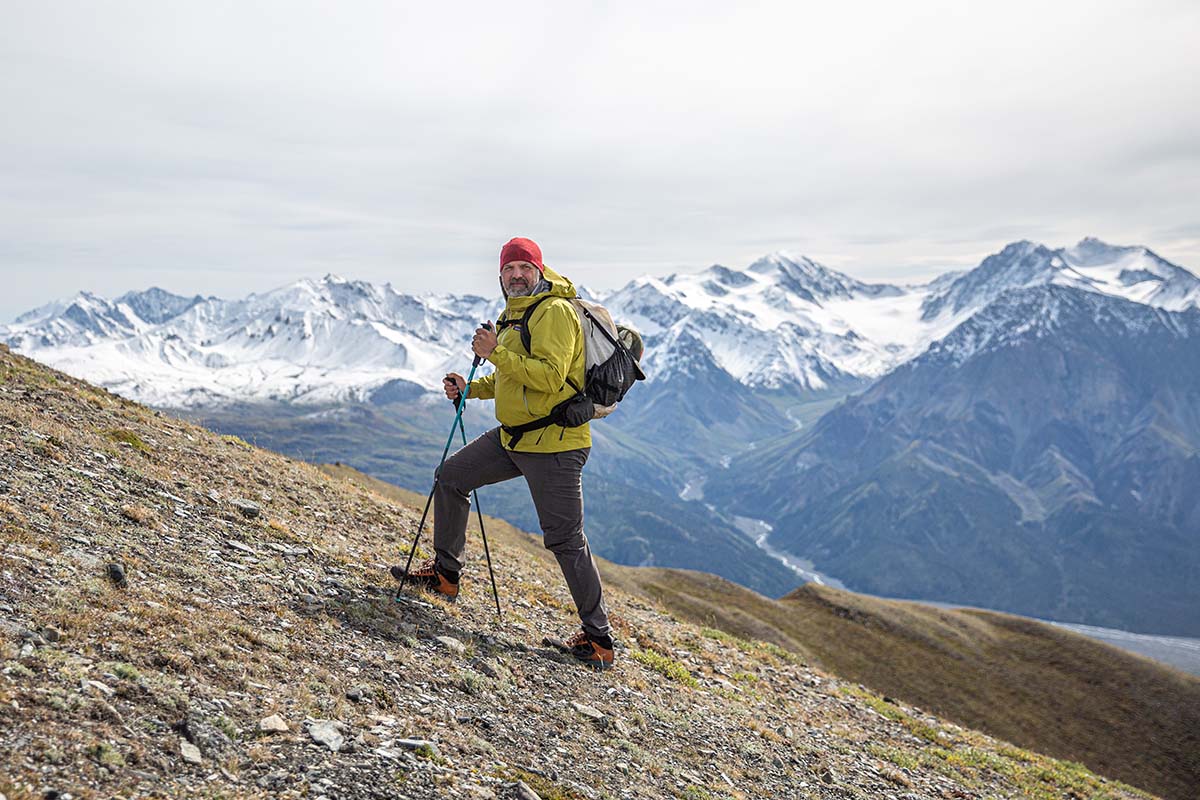
Rain jackets aren’t often lauded for their comfort, but the Granite Crest is reasonably cozy and easy to wear. The H2No fabric has a slight stretch to it, which promotes great mobility with no restriction to movement. The interior isn’t particularly soft or supple against the skin and does grow fairly clammy during exertion, but that’s been my experience with most rain shells—even those that feature higher-end Gore-Tex waterproofing. Patagonia also included a zipper garage at the top of the main zipper, which helps prevent my facial hair from snagging (a small but thoughtful touch). Added up, it’s easy to put the Granite Crest on and forget about it.
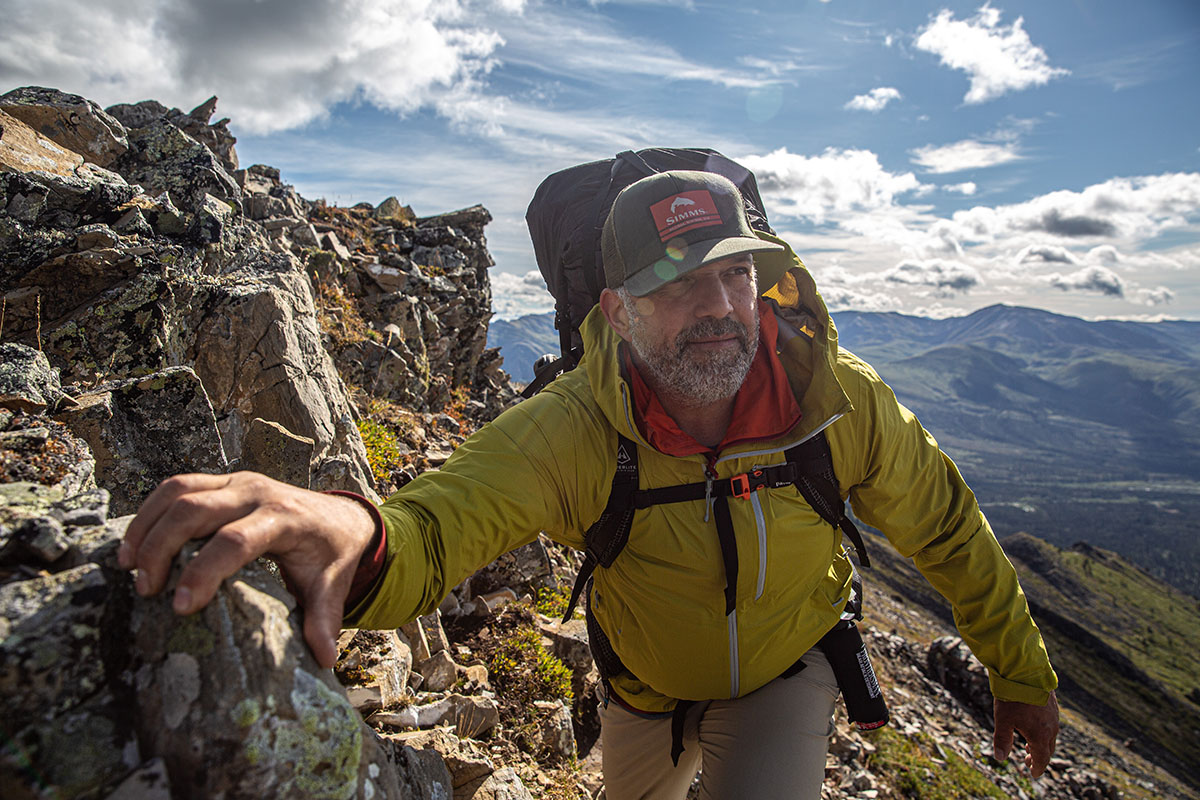
At 1 pound even on my scale in a men’s large (listed weight is a little lower at 14.1 oz.), the Granite Crest is no featherweight but has a reasonably light and streamlined feel. To be sure, I’d be more likely to pack a jacket like Arc’teryx’s Beta SL (12 oz.) or Norrøna’s Falketind Gore-Tex Paclite (9.1 oz.) on weight-conscious backcountry missions, but the Granite Crest was perfectly serviceable for our trip to the Yukon, which involved several days of backpacking. And importantly, the jacket packs down quite well, with the left chest pocket doubling as the stuff sack. Once zipped shut, the package is about the size of a small cantaloupe. To save time, it’s equally easy to roll the Granite Crest up and stuff it into the hood.
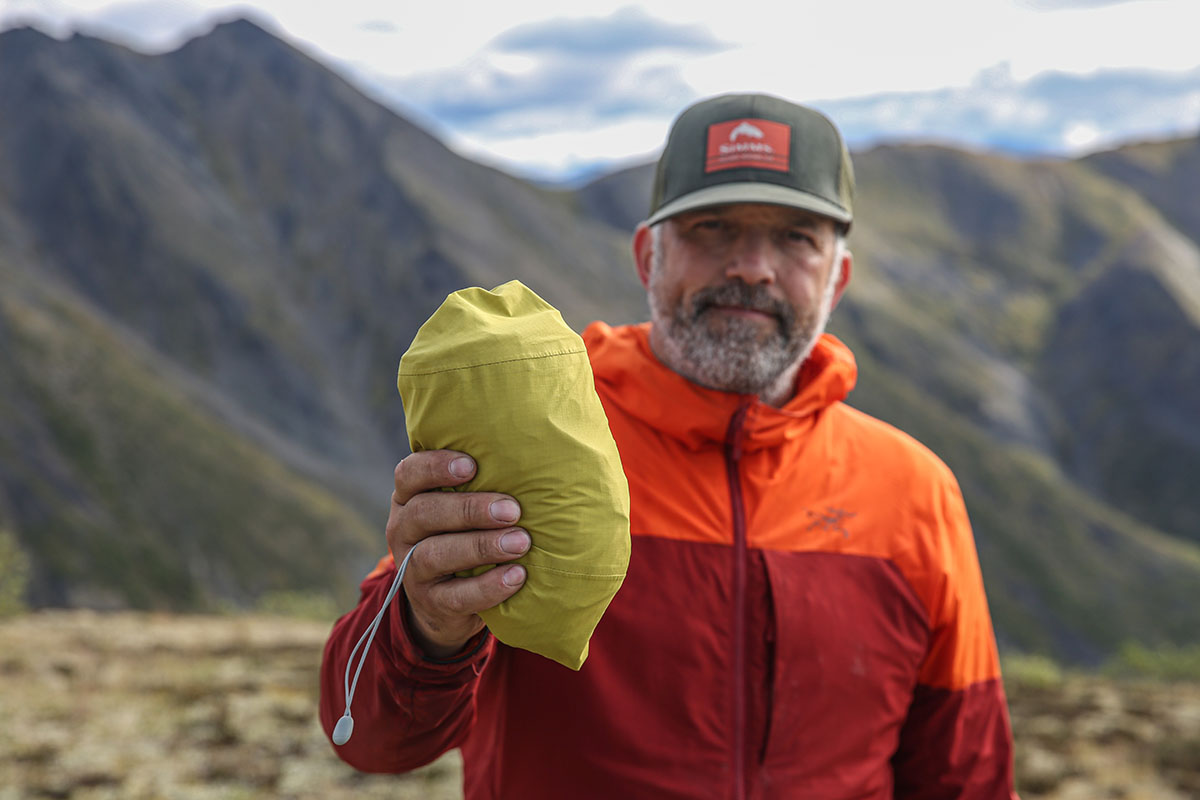
Patagonia is no stranger to quality gear, and the Granite Crest is yet another thoughtfully built and outdoor-ready design. While not the thickest available, the 30-denier (D) shell is reasonably durable and has held up flawlessly throughout testing. Apart from the back wetting out in a downpour, I haven’t had any issues with water- or windproofing, and the exterior is free of snags, tears, and peeled seams. The shoulders are also holding up well despite frequent contact with a 50-pound backpacking pack, and all of the smaller components—including the zippers, hook-and-loop cuff adjustments, and drawcords—are in perfect working order. Given my experiences thus far, I expect the Granite Crest will have a healthy lifespan.
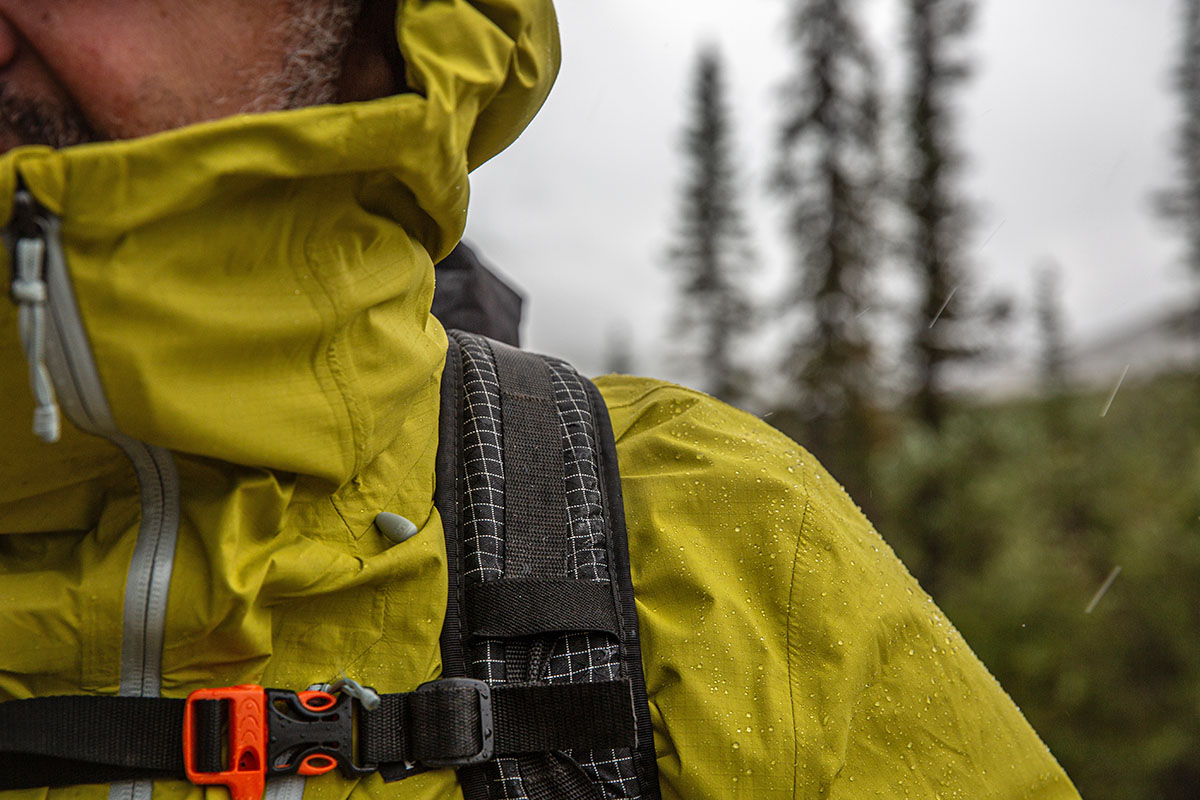
Hood design can make or break a rain jacket, and I’m happy to report that the Granite Crest has a good one. In addition to being large enough to fit over a climbing helmet, you get three drawcords for dialing in fit: one at the back for fine-tuning the halo/brim and two at the base of the collar that adjusts the aperture. Importantly, all of them are easy to access and toggle, even when wearing gloves, and I’ve had no issues with security even in high winds. Combined with the tall collar that reaches above my chin, the net result is great coverage and a battened-down feel in rowdy weather.
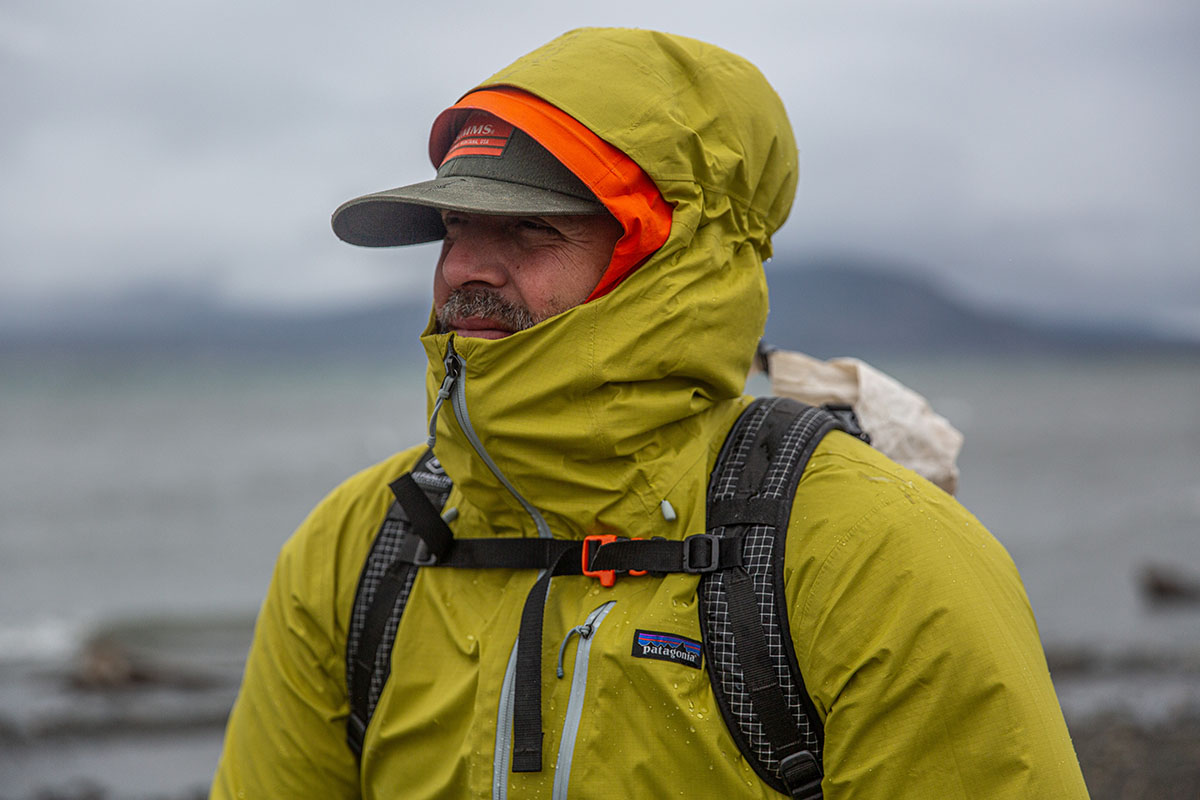
While not a standout in organization, the Granite Crest is adequately equipped for divvying up the essentials on the trail. The zippered hand pockets are large enough to comfortably fit gloved hands or store a camera lens, while the single chest pocket is great for stashing a map, headlamp, or wallet. As I touched on above, this pocket also doubles as a stuff sack. I did find myself wishing for an internal pocket to keep items farther from moisture and more secure throughout the day (I tend to zip and unzip the exterior pockets quite frequently), but it’s not a dealbreaker by any means.
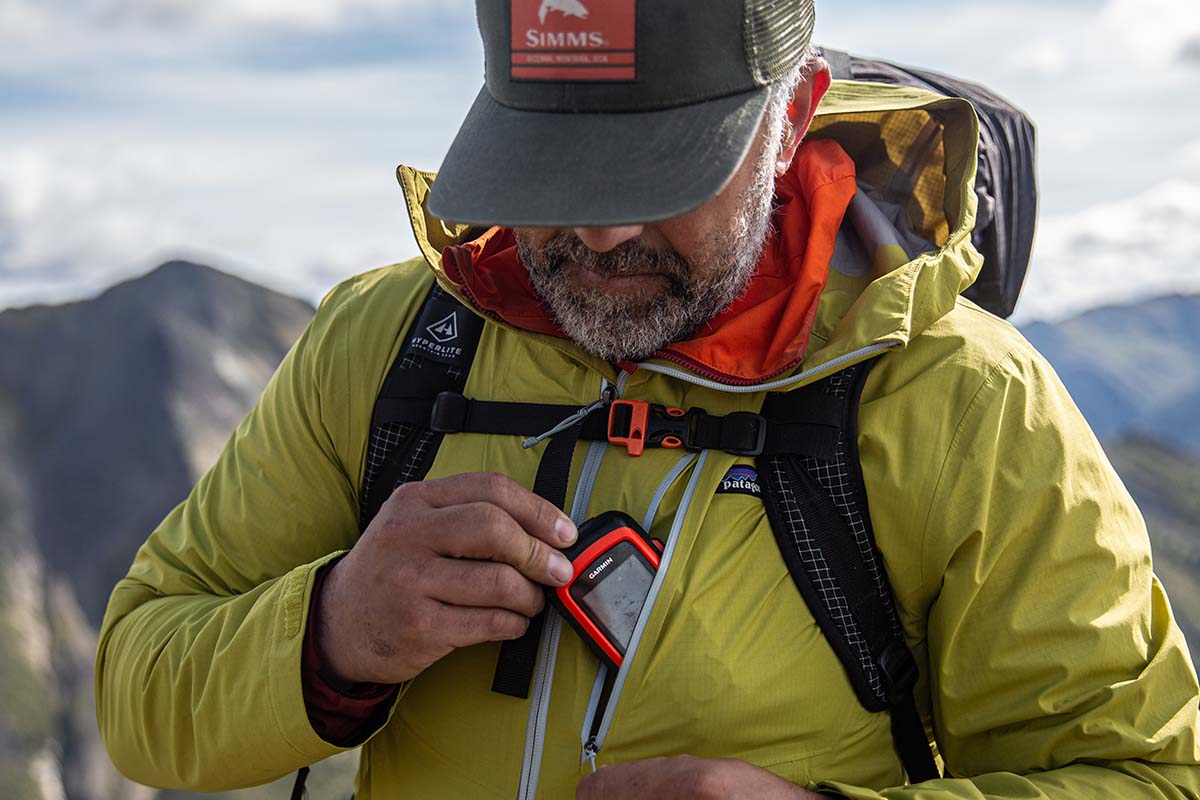
Dubbed a “regular” fit by Patagonia, the Granite Crest was spot-on in my usual men’s size large. In testing, it comfortably layered over my Arc’teryx Cerium Hybrid Hoody, as well as the thicker and puffier Norrøna Falketind Down750 Hood Jacket. I often notice some restriction under my arms when wearing thicker midlayers underneath my shell, but that hasn’t been an issue with the Granite Crest. And importantly, it’s still trim enough to slide under a winter-ready parka. All in all, it’s an accommodating but flattering shape, and the healthy range of sizing options (from XXS to 3XL) means most should be able to find a good all-around fit.
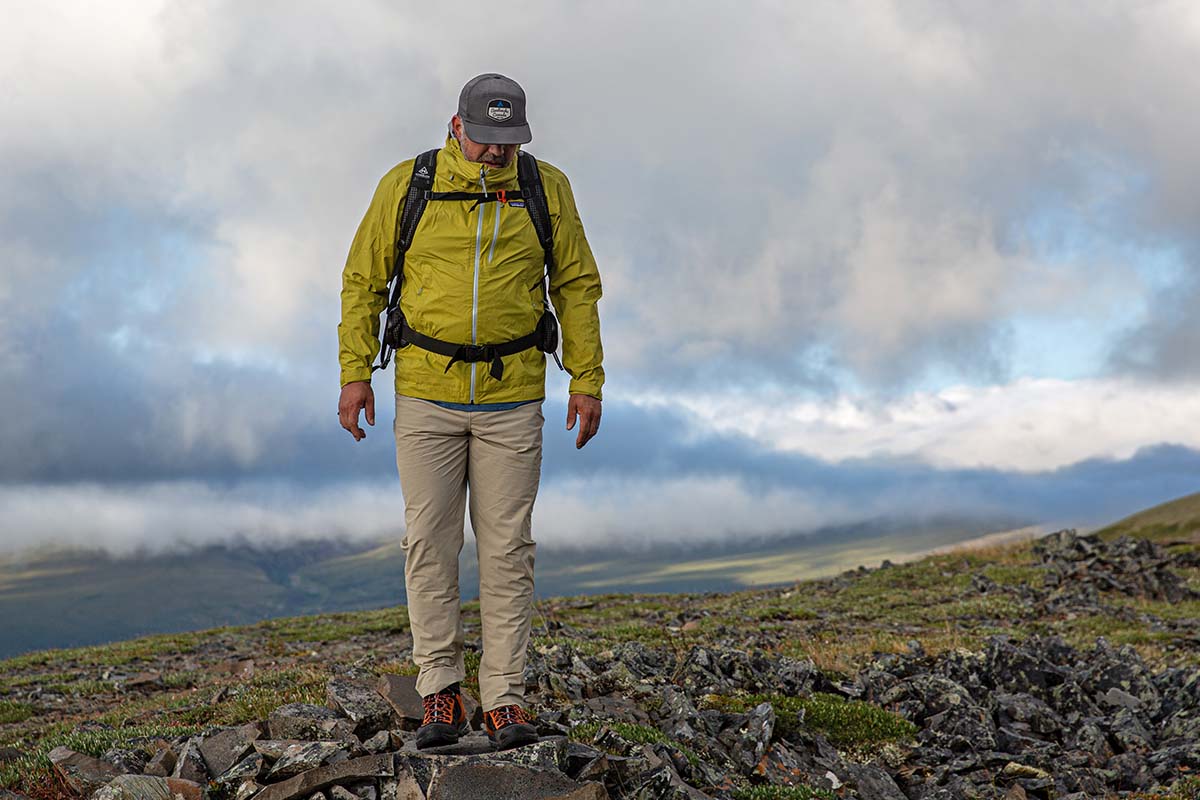
Patagonia is a consistent leader in the sustainability realm, and the Granite Crest Rain Jacket carries the torch. For starters, the shell is made entirely from recycled fishing nets and coated with a PFAS-free DWR coating that forgoes the use of harmful per- and polyfluoroalkyl substances, which are known as “forever chemicals” due to their inability to break down over time. Like most of Patagonia’s products, the Granite Crest is also produced in a Fair Trade Certified factory, which ensures factory workers are treated fairly and ethically. Taken together, it’s another intentional effort from the brand and a nice reflection of where the industry is headed.
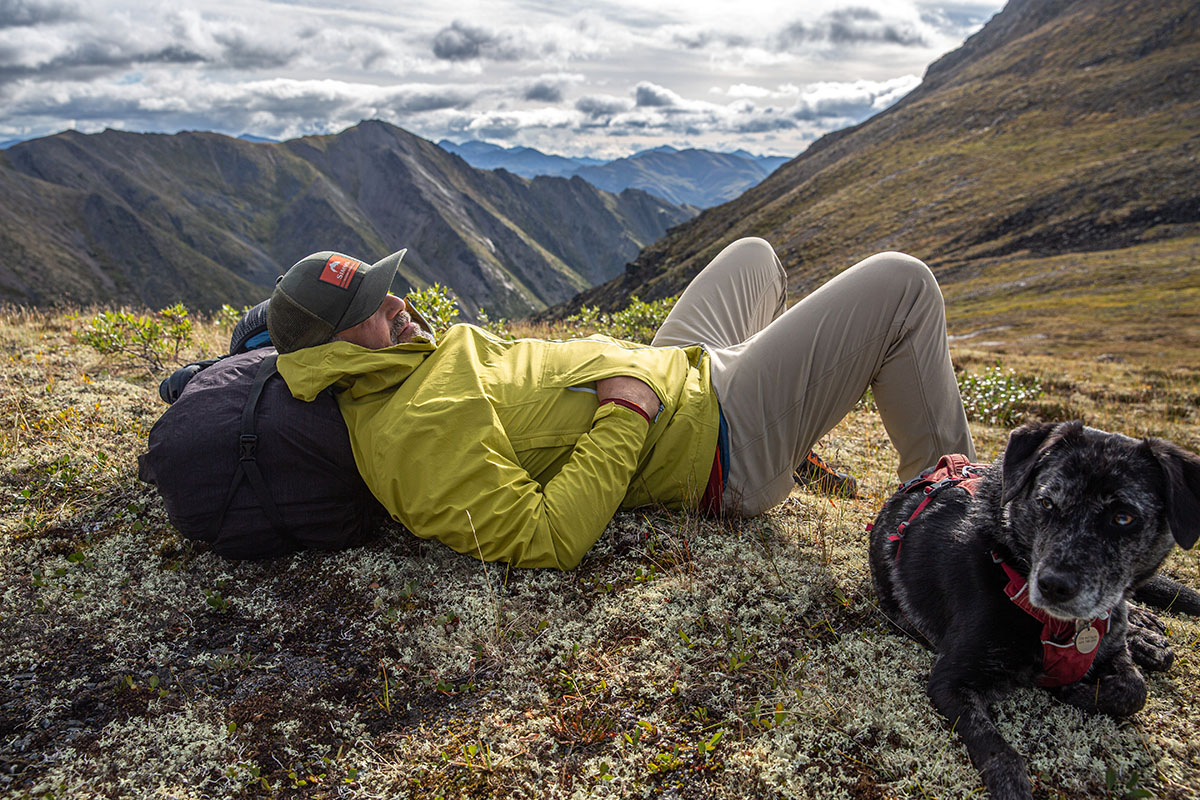
We cover the men’s Granite Crest above, and it’s also available in a women’s version for the same price. In comparing the two, the women’s Granite Crest Jacket is slightly lighter at 12.6 ounces and offered in different colorways but boasts an otherwise identical feature set and overall construction (for more, see our in-depth review of the women’s model). Rounding out the collection, Patagonia offers Granite Crest Rain Pants in both men’s and women’s styles, which retail for $229 and feature the same 3-layer H2No build.
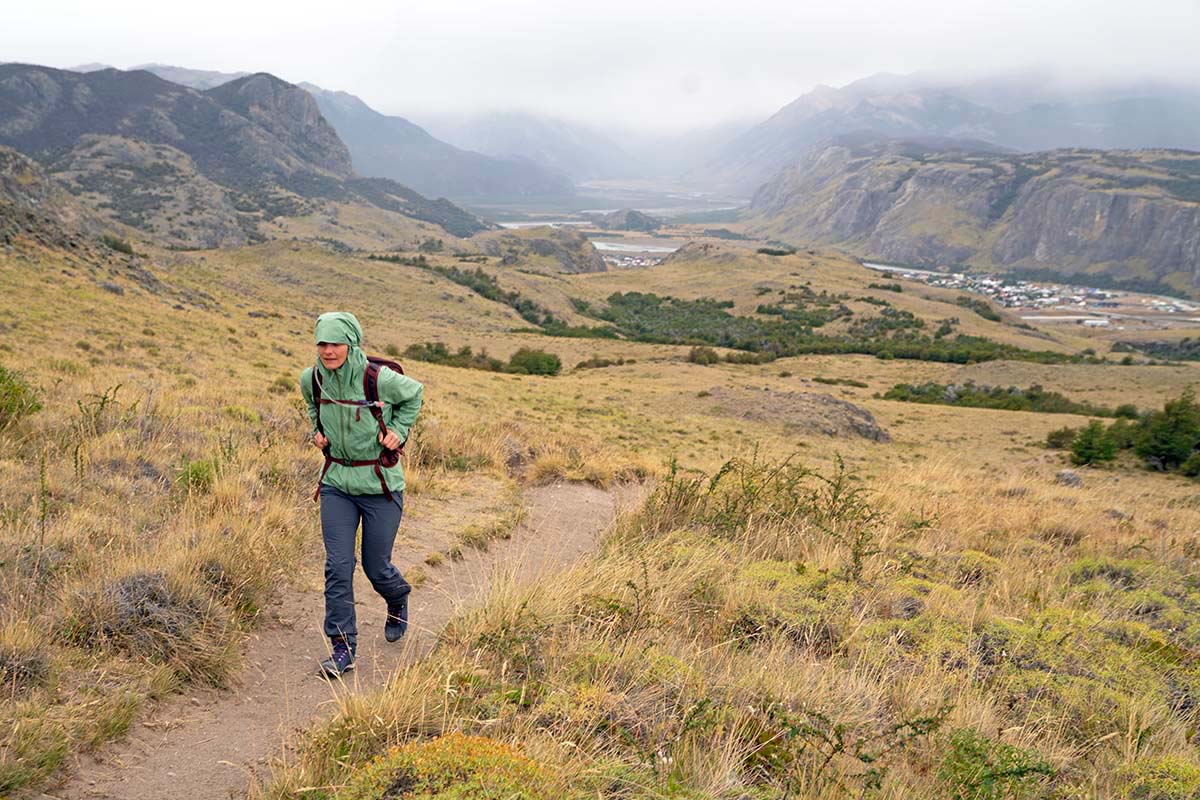
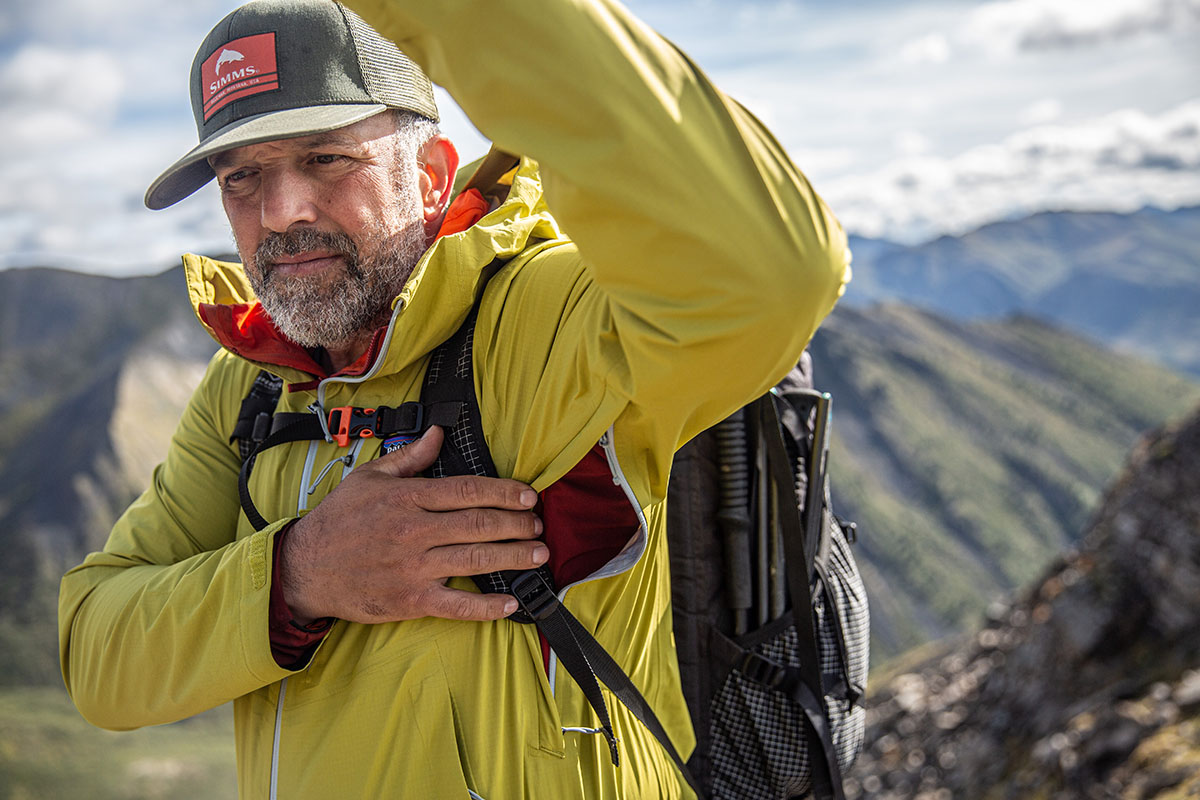
| Jacket | Price | Weight | Category | Waterproofing | Pit Zips | Packable |
|---|---|---|---|---|---|---|
| Patagonia Granite Crest | $279 | 14.1 oz. | Performance/hiking | 3L H2No | Yes | Yes |
| Patagonia Torrentshell 3L | $179 | 14.1 oz. | Daily use/hiking | 3L H2No | Yes | Yes |
| Patagonia Boulder Fork | $229 | 13.7 oz. | Hiking/daily use | 3L H2No | No | No |
| Outdoor Research Foray 3L | $249 | 15.3 oz. | Hiking/daily use | 3L AscentShell | Yes | No |
| Marmot Minimalist | $220 | 13.0 oz. | Hiking/daily use | 2.5L Gore-Tex | Yes | No |
The Granite Crest is a well-rounded and sustainably built rain jacket, but our favorite option this year is another Patagonia design: their Torrentshell 3L Jacket. For the same weight as the Granite Crest, the Torrentshell is both cheaper ($179) and more durable with a 50D shell fabric (compared to the 30D Granite Crest). You also get a cozy micro fleece lining inside the collar, which the Granite Crest lacks, along with both internal and external storm flaps protecting the main zipper. The Granite Crest wins out in storage with three pockets versus the Torrentshell’s two and has an overall suppler and more streamlined feel—the Torrentshell is pretty stiff by comparison—but those advantages aren’t enough to justify the $100 price jump, in our opinion.

Another Patagonia design to have on your radar is their newer Boulder Fork, which we recently tested while backpacking in Patagonia. For $50 less than the Granite Crest, the Boulder Fork features a similarly solid 3-layer H2No construction, shares the same 30D face fabric, and boasts three pockets for divvying up the essentials. That said, you do make some sacrifices by saving: The Boulder Fork’s hood only has one adjustment point for dialing in fit, there are no pit zips for dumping heat, and you don’t get a dedicated stuff pocket for packing the jacket down (for more, check out our in-depth Boulder Fork review). These won’t be dealbreakers for everyone, but we personally feel the Granite Crest is worth the added investment—especially considering the Boulder Fork is only 0.4 ounces lighter.
Moving away from Patagonia’s lineup, Outdoor Research is another leader in the rain shell market, and their Foray 3L Jacket stacks up closely to the Granite Crest in all-around performance. Recently upgraded from a basic 2-layer build to a more premium 3-layer construction, the Foray balances its priorities quite well, including reliable protection and competitive breathability thanks to OR’s in-house AscentShell membrane and the brand’s unique hem-to-bicep vents. Most other features line up well, including an adjustable hood with a protective brim, water-resistant zippers, and a practical storage layout. The Foray is a little heavier than the Granite Crest at 15.3 ounces but offers comparable overall performance for less, earning it our vote over the Patagonia.
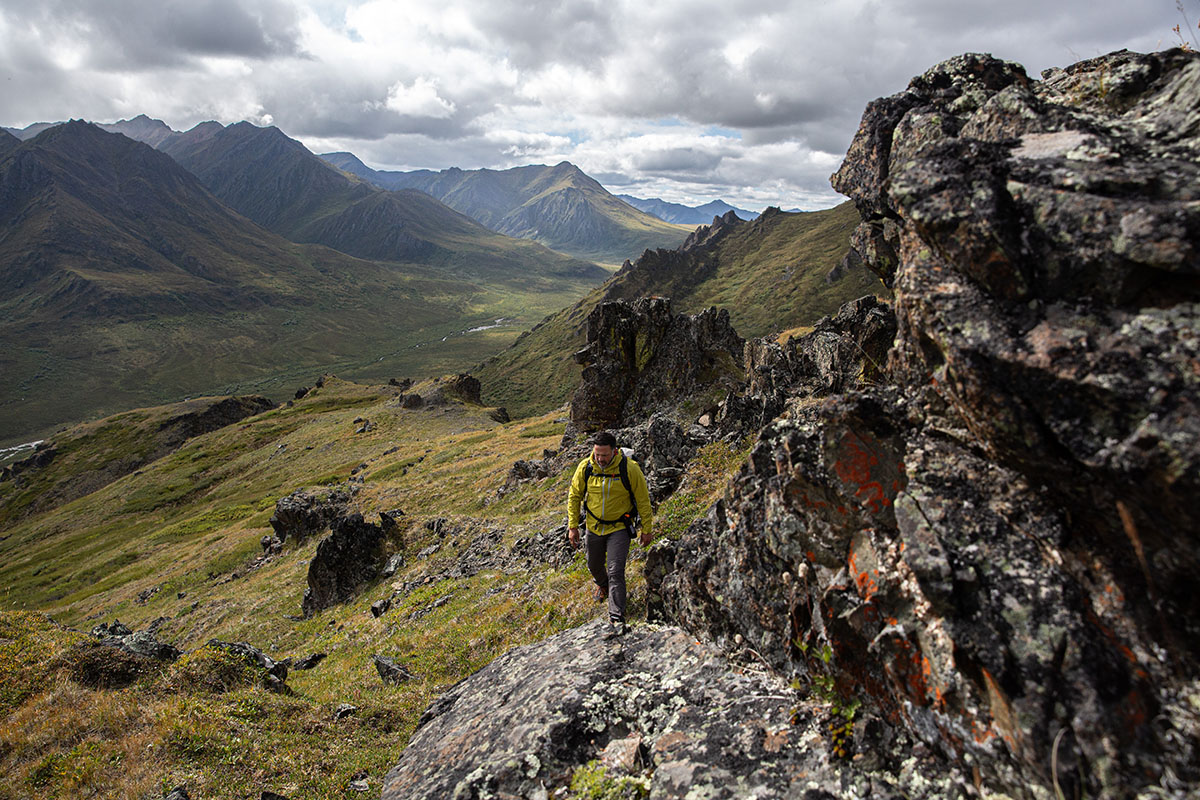
A final option to consider is Marmot’s longstanding Minimalist, which will save you around $60 over the Granite Crest. In this case, Marmot opted for a 2.5-layer Gore-Tex Paclite build, which is less premium and breathable than Patagonia’s 3-layer design but trustworthy nonetheless. The Marmot is also competitively light at 13 ounces, boasts pit zips to keep you comfortable on the move, and has a similar feature set that includes three pockets, an adjustable hood, and Velcro cuffs. All that said, the Granite Crest feels noticeably higher-end than the Minimalist, and overall fit and finish are a sizable step up. Some won’t mind the more plasticky feel of the Marmot, but if you often wear your rain jacket with just a T-shirt underneath, it may be worth upgrading to the Granite Crest.
If you’re thinking about buying gear that we’ve reviewed on Switchback Travel, you can help support us in the process. Just click on any of the seller links above, and if you make a purchase, we receive a small percentage of the transaction. The cost of the product is the same to you but this helps us continue to test and write about outdoor gear. Thanks and we appreciate your support!
Depending on the seller, most products ship free in the United States on orders of $50 or more. International shipping availability and rates vary by seller. The pricing information on this page is updated hourly but we are not responsible for inaccuracies.